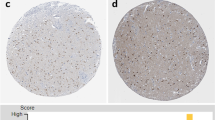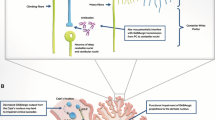Abstract
Background
AP3B2 is one of the subunits of vesicle coat protein AP3 and is specifically expressed in central nervous system neurons. AP3B2 antibody has been reported in patients with autoimmune cerebellar ataxia and various extracerebellar symptoms. However, there have been few reports on its clinical features and treatment response.
Methods
We report a 47-year-old man with AP3B2 antibody who presented with insidious-onset paresthesia and gait disturbance. His serum and cerebrospinal fluid (CSF) showed reactivity with the cytoplasm of Purkinje cells and granular layer synapses comparable to the reported specific pattern of anti-AP3B2 IgG, and this was confirmed by a cell-based assay. His symptoms improved after the administration of intravenous immunoglobulin, and oral prednisone and mycophenolate mofetil. Extensive examination and long-term follow-up showed no evidence of malignancy. A literature review was included to emphasize the neurological syndrome associated with this rare autoantibody.
Results
Eleven cases with AP3B2 antibody, including our patient, were identified. The diversity of symptoms, including cerebellar and sensory ataxia, paresthesia, and weakness, was in line with the extensive binding of AP3B2 antibody to the spinal cord gray matter, dorsal root ganglia, cerebellar cortex, and nucleus. In the CSF, half of patients had elevated white blood cell counts, increased protein concentrations, or CSF-specific oligoclonal bands. All previous cases had subacute onsets and no improvement was noted after immunotherapy.
Conclusion
Our case indicated that disorders associated with AP3B2 antibody can also start insidiously. Immunotherapy is warranted given the possibility of clinical improvement.



Similar content being viewed by others
References
Assoum M, Philippe C, Isidor B, Perrin L, Makrythanasis P, Sondheimer N, Paris C, Douglas J, Lesca G, Antonarakis S, Hamamy H, Jouan T, Duffourd Y, Auvin S, Saunier A, Begtrup A, Nowak C, Chatron N, Ville D, Mireskandari K, Milani P, Jonveaux P, Lemeur G, Milh M, Amamoto M, Kato M, Nakashima M, Miyake N, Matsumoto N, Masri A, Thauvin-Robinet C, Rivière J-B, Faivre L, Thevenon J (2016) Autosomal-recessive mutations in AP3B2, adaptor-related protein complex 3 beta 2 subunit, cause an early-onset epileptic encephalopathy with optic atrophy. Am J Hum Genet 99:1368–1376
Danglot L, Galli T (2007) What is the function of neuronal AP-3? Biol Cell 99:349–361
Darnell RB (1996) Onconeural antigens and the paraneoplastic neurologic disorders: at the intersection of cancer, immunity, and the brain. Proc Natl Acad Sci USA 93:4529–4536
Darnell RB, Furneaux HM, Posner JB (1991) Antiserum from a patient with cerebellar degeneration identifies a novel protein in Purkinje cells, cortical neurons, and neuroectodermal tumors. J Neurosci 11:1224–1230
Ercoli T, Defazio G, Muroni A (2019) Cerebellar syndrome associated with thyroid disorders. Cerebellum 18:932–940
Evstratova A, Chamberland S, Faundez V, Tóth K (2014) Vesicles derived via AP-3-dependent recycling contribute to asynchronous release and influence information transfer. Nat Commun 5:5530
Faúndez V, Horng JT, Kelly RB (1998) A function for the AP3 coat complex in synaptic vesicle formation from endosomes. Cell 93:423–432
Hadjivassiliou M, Graus F, Honnorat J, Jarius S, Titulaer M, Manto M, Hoggard N, Sarrigiannis P, Mitoma H (2020) Diagnostic criteria for primary autoimmune cerebellar ataxia-guidelines from an international task force on immune-mediated cerebellar ataxias. Cerebellum 19:605–610
Hadjivassiliou M, Grunewald RA, Shanmugarajah PD, Sarrigiannis PG, Zis P, Skarlatou V, Hoggard N (2020) Treatment of primary autoimmune cerebellar ataxia with mycophenolate. Cerebellum 19:680–684
Honorat JA, Lopez-Chiriboga AS, Kryzer TJ, Komorowski L, Scharf M, Hinson SR, Lennon VA, Pittock SJ, Klein CJ, McKeon A (2019) Autoimmune gait disturbance accompanying adaptor protein-3B2-IgG. Neurology 93:e954–e963
Jarius S, Wildemann B (2015) ’Medusa head ataxia: the expanding spectrum of Purkinje cell antibodies in autoimmune cerebellar ataxia Part 3: Anti-Yo/CDR2, anti-Nb/AP3B2, PCA-2, anti-Tr/DNER, other antibodies, diagnostic pitfalls, summary and outlook. J Neuroinflammation 12:168
Li P, Merrill SA, Jorgensen EM, Shen K (2016) Two clathrin adaptor protein complexes instruct axon-dendrite polarity. Neuron 90:564–580
Lim DS, Kirsch DG, Canman CE, Ahn JH, Ziv Y, Newman LS, Darnell RB, Shiloh Y, Kastan MB (1998) ATM binds to beta-adaptin in cytoplasmic vesicles. Proc Natl Acad Sci USA 95:10146–10151
Mitoma H, Hadjivassiliou M, Honnorat J (2015) Guidelines for treatment of immune-mediated cerebellar ataxias. Cerebellum Ataxias 2:14
Mitoma H, Manto M, Hampe CS (2019) Immune-mediated cerebellar ataxias: practical guidelines and therapeutic challenges. Curr Neuropharmacol 17:33–58
Newman LS, McKeever MO, Okano HJ, Darnell RB (1995) Beta-NAP, a cerebellar degeneration antigen, is a neuron-specific vesicle coat protein. Cell 82:773–783
Shaw PJ, Walls TJ, Newman PK, Cleland PG, Cartlidge NE (1991) Hashimoto’s encephalopathy: a steroid-responsive disorder associated with high anti-thyroid antibody titers–report of 5 cases. Neurology 41:228–233
Weihua Z, Haitao R, Fang F, Xunzhe Y, Jing W, Hongzhi G (2019) Neurochondrin antibody serum positivity in three cases of autoimmune cerebellar ataxia. Cerebellum 18:1137–1142
Xu X, Ren H, Li L, Wang J, Fechner K, Guan H (2019) Anti-Homer-3 antibody associated cerebellar ataxia: a rare case report and literature review. J Neuroimmunol 330:155–158
Zis P, Rao DG, Hoggard N, Sarrigiannis PG, Hadjivassiliou M (2018) Anti-MAG associated cerebellar ataxia and response to rituximab. J Neurol 265:115–118
Author information
Authors and Affiliations
Corresponding author
Ethics declarations
Conflicts of interest
The author declares that there is no conflict of interest.
Ethical approval
This study was approved by the Ethics Committee of Peking Union Medical College Hospital (JS-891).
Informed consent
All included patients or their deputies provided written informed consent.
Supplementary Information
Below is the link to the electronic supplementary material.
Rights and permissions
About this article
Cite this article
Mange, L., Haitao, R., Lixin, Z. et al. Cerebellar ataxia and myeloradiculopathy associated with AP3B2 antibody: a case report and literature review. J Neurol 268, 4163–4169 (2021). https://doi.org/10.1007/s00415-021-10496-8
Received:
Revised:
Accepted:
Published:
Issue Date:
DOI: https://doi.org/10.1007/s00415-021-10496-8




